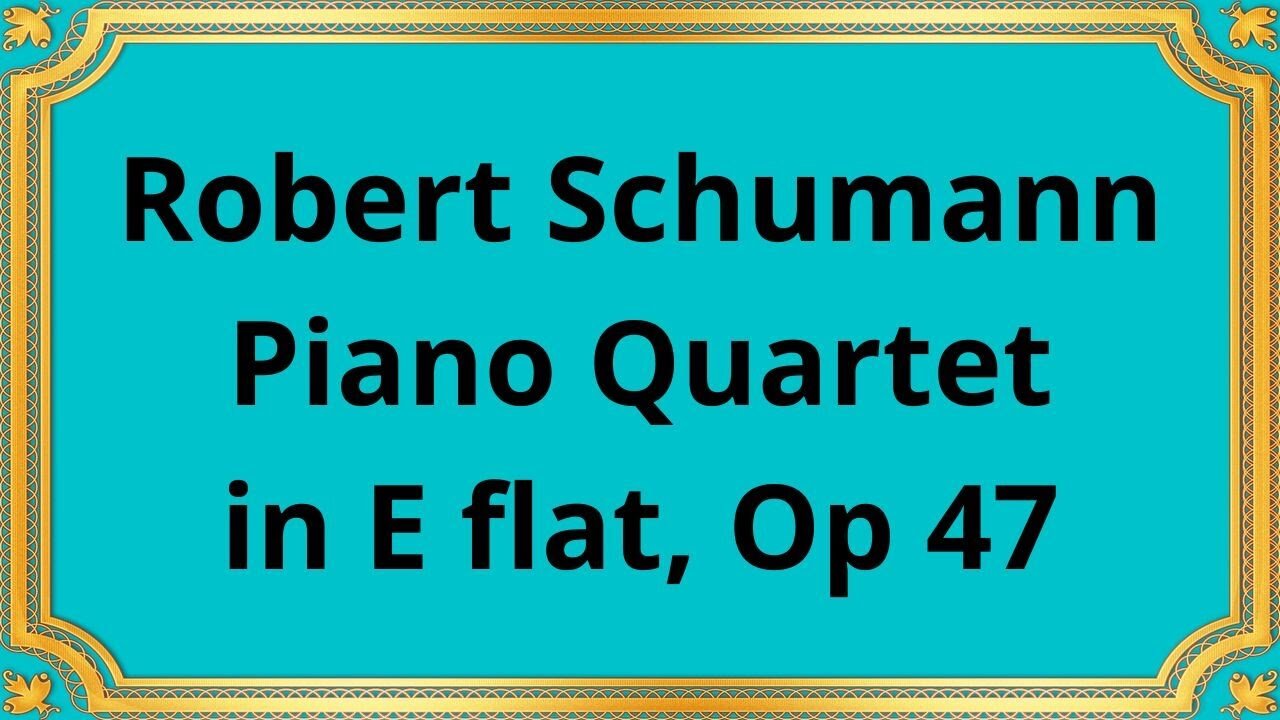Premium Only Content

Robert Schumann Piano Quartet in E flat, Op 47
#RobertSchumann #PianoQuartet #ClassicalMusic #MusicalComposition #EFlat #Op47 #ChamberMusic #MusicPerformance #MusicHistory #MusicAppreciation
Beaux Arts Trio, Samuel Rhodes
Robert Schumann's Piano Quartet in E flat, Op. 47 is a compelling musical composition that showcases the composer's mastery of melodic invention and harmonic exploration. Composed in 1842, this quartet represents a significant contribution to the chamber music repertoire of the Romantic era.
Robert Schumann, a prominent figure in 19th-century German music, composed the Piano Quartet during a period of intense creativity. It was written shortly after his marriage to Clara Wieck, a highly accomplished pianist. The quartet was premiered in Leipzig in 1843, performed by Clara Schumann on the piano and a distinguished ensemble of string players.
The Piano Quartet in E flat follows the conventional four-movement structure commonly found in chamber music compositions. The movements are as follows:
1. Sostenuto assai - Allegro ma non troppo: The opening movement is characterized by its expressive and contemplative nature. It begins with a lyrical and melancholic theme in the strings, accompanied by delicate piano chords. The music gradually builds in intensity, leading to a lively and energetic section that showcases Schumann's harmonic innovation.
2. Scherzo: Molto vivace - Trio I - Trio II: The second movement is a lively and spirited scherzo, featuring rapid and playful exchanges between the instruments. The contrasting trio sections provide a moment of respite with their lyrical melodies and delicate textures. This movement displays Schumann's ability to create contrasting moods within a single composition.
3. Andante cantabile: The third movement is a beautiful and introspective adagio. It features a tender and lyrical melody played by the strings, accompanied by the piano's delicate harmonies. This movement showcases Schumann's gift for creating deeply expressive and emotionally evocative music.
4. Finale: Vivace: The final movement is a vibrant and exhilarating finale. It is characterized by its energetic and driving rhythm, showcasing the technical prowess of all four instruments. The movement weaves together themes from previous movements, creating a sense of unity and closure.
Schumann's Piano Quartet in E flat is known for its rich harmonies, expressive melodies, and intricate interplay between the piano and the string instruments. The composition showcases Schumann's innovative approach to harmony and his ability to create a sense of tension and release. The quartet also displays the composer's skill in developing and transforming musical themes throughout the piece, creating a coherent and engaging musical narrative.
Conclusion:
Robert Schumann's Piano Quartet in E flat, Op. 47 is a testament to the composer's prowess in chamber music composition. Its combination of expressive melodies, harmonic richness, and intricate interplay between the piano and strings make it a significant work in the Romantic repertoire. This composition continues to captivate audiences with its emotional depth and serves as a testament to Schumann's enduring legacy in the world of classical music.
You have the opportunity to support the channel:
https://destream.net/live/RadSiarAl/donate
https://www.buymeacoffee.com/6355radsiaral
-
 48:22
48:22
Classical music_Music Inspiration
1 month agoHector Berlioz Fantastic Symphony
791 -
 LIVE
LIVE
Due Dissidence
7 hours agoGaza STARVATION Hits Tipping Point, Flotilla CAPTURED, Bongino BREAKS SILENCE, Maxwell MEETS DOJ,
1,874 watching -
 LIVE
LIVE
GritsGG
8 hours agoWin Streaking! Most Wins 3180+! 🔥
852 watching -
 LIVE
LIVE
This is the Ray Gaming
53 minutes agoSunday Night LIVE | Rumble Premium Streamer
83 watching -
 2:42:31
2:42:31
Barry Cunningham
6 hours agoPRESIDENT TRUMP IS SAVING AMERICA ONE DEAL AT A TIME! UNBELIEVABLE!
42.4K26 -
 LIVE
LIVE
EricJohnPizzaArtist
5 days agoAwesome Sauce PIZZA ART LIVE Ep. #56: Bret “The Hitman” Hart Tribute with SoundBoardLord!
234 watching -
 LIVE
LIVE
HELMETFIRE
1 hour ago🟢GAMING WITH FIRE EP4🟢RUMBLE TAKEOVER!🟢
12 watching -
 LIVE
LIVE
iCheapshot
2 hours agoCheap Plays Warzone Again? What!?
73 watching -
 2:30:14
2:30:14
PandaSub2000
4 hours agoCHAOS & FURY | Episode 27: Attack Of The Cranks (Edited Replay)
37 -
 LIVE
LIVE
Spartan
1 hour agoSpartan - Pro Halo Player for OMiT | Ranked for a little bit
14 watching